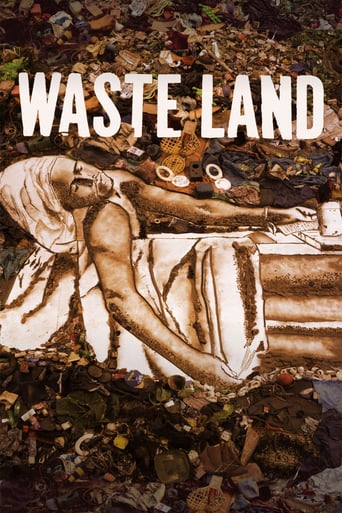

In this uplifting documentary film a contemporary American artist Vik Muniz goes on a life-changing journey back to his homeland, Brazil. Together with his film crew he travels to Rio de Janeiro to realize another massive art project of his. However, to our surprise, instead of showing us the city that we all know, with its beautiful sandy shores, outstanding scenery and the breathtaking view on the statue of Jesus, he takes us to Jardim Gramacho, the world's largest landfill located just on the outskirts of Rio. Vik's primary goal during this trip is to try to give back to the society he grew up in, to the people who come from the same background he once did. Those people are "catadores" or "the pickers". They spend every day working on this huge dump picking through the mountains of garbage in order to sort out the recyclable materials, without any masks or special equipment available. Those people come from the lowest poor class, choosing this job as a preferred option to begging or prostitution.Vik comes to Jardim Gramacho and starts taking pictures of the pickers, men and women. Under his supervision and guidance those pictures are remade by the pickers themselves from the collected waste materials found on the landfill. Together they create massive video installations which get later on sold all over the world at the best auction houses. All the money from the art pieces goes to the pickers to help them realize their dreams.During the course of the film you notice how taking part in creation of pieces of art, which at first might have seemed a waste of time to them, transforms the pickers completely. Gradually, they start believing not only in the power of art, but most importantly in themselves. You get constantly amazed by the inner-beauty, cheerfulness and dignity of those people who have been put in such difficult life circumstances, which could easily break anyone.The movie thus is a triumph of the human spirit and the unity of people, bringing up and beautifully mixing together such serious topics as poverty, environmental problems, education and art. You start to believe that the problem of poverty is actually solvable, mostly with the means of raising awareness, funds and promoting education among those in need. As after all, after being exposed to art the pickers never went back to the landfill, they believed they deserved more and went on to realize their dreams.
... View MoreIt never ceases to amaze me how people can change lives when they decide to. There are so many out there that have the capability and means to make a difference and do so. Vik is an inspiration. He remembers where he grew up and does what he can to help many who hail from the same area in Rio. Lovely, hard-working people that love their families, opportunities and lives. So many of us that struggle with daily grind and complaints need to turn to films such as these to see how fortunate we really are. I know I am, blessed indeed. I truly do care about these folks and was moved by their lives. Everyone has a story and many are not easy to hear, but they put the stories out there. No qualms, no shame. We should all be so open and realize what fortunes we do have.
... View MoreI have developed a love for films and documentaries coming out of Brazil, particularly with Elite Squad 1 and 2, films that completely blow my mind. I therefore had high hopes for this documentary, especially as it had a 7.8 on IMDb. The documentary starts off well, that is for the first 5 minutes, then what you begin to experience is pure narcissism. The recycling story is an interesting one and the lives the pickers lead is one that could have been explored on a deeper level that would have made for a great documentary. Instead this is all about one over-inflated ego promoting himself with final products unable to live up to expectations. This documentary is only worth watching to see the pickers, the rest is a waste of time.
... View MoreI loved this film for its beauty.Waste Land helped build my understanding and appreciation of modern art from almost zero aside from MIT's Walter Lewin lecture on Modern Art - who is adamant that modern art is supposed to be "ugly" and change the way one looks at things. Vic Muniz, the artist in the film takes this further by explaining how to look at art: stand back to get the idea, get closer to look at the materials and detail the artist uses.Vic uses the same technique to get to know the landscape and the subjects of his film first looking at them from aerial photos/plane and then on the ground. Astonishing how this transforms the subjects and landscape from a rubbish tip to beautiful and inspiring people and works of art. His subjects were totally in tune and connected with their environment in the landfill.By the end of the film even Vic's wonderful, tasteful, designer home in NY looked like a slightly more orderly version of his subject's favelas.
... View More